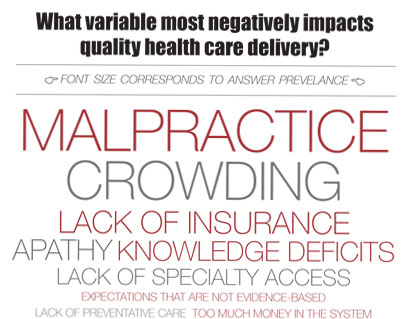STAT! EMERGENCY MEDICINE BY THE NUMBERS
235 emergency physicians responded to EPM’s quality care survey
Here’s what you had to say…
Here’s what you had to say…
235 emergency physicians responded to EPM’s quality care survey
Here’s what you had to say…
Here’s what you had to say…
Should physicians who provide care using fewer diagnostic tests and resources be compensated more than those who do not?
No – 70%
Yes – 30%
Should physicians who provide care resulting in better patient outcomes be compensated more than those who do not?
No – 35%
Yes – 65%
Should the utilization of diagnostic testing be considered when third-party payors compensate emergency physicians?
No – 65%
Yes – 35%
Is it fair for emergency physicians to be compensated by third-party payors based on quality of care?
No – 59%
Yes – 41%
33 Percentage
of respondents who report that they would stop practicing clinical emergency medicine should the government implement a “universal governmental pay-for-performance plan”.
of respondents who report that they would stop practicing clinical emergency medicine should the government implement a “universal governmental pay-for-performance plan”.
72 Percentage
of respondents who felt that “patient outcomes” is what defines quality care. 28% felt that “following accepted standards of care” is what defines quality care.
of respondents who felt that “patient outcomes” is what defines quality care. 28% felt that “following accepted standards of care” is what defines quality care.
95 Percentage
who report that their group incentivizes pay based on “productivity.” For 41%, compensation is incentivized based on “patient satisfaction,” and for 25%, incentives are based on “quality”.
83 Percentage
of respondents who report that CMS PQRI measures are NOT appropriate for measuring quality of care in emergency medicine

75% of respondents say that intermediary parties like insurance companies and managed care organizations do not improve quality, particularly given the millions of dollars they make each year.
Quality assessment literature exists, but the reviews are extremely long
(100+ pages) and difficult to read. We asked readers to suggest ways to make these quality assessment reviews easier to disseminate. A few popular answers:
(100+ pages) and difficult to read. We asked readers to suggest ways to make these quality assessment reviews easier to disseminate. A few popular answers:
1. Instead of a lengthy packet, should come in summarized bulleted form
2. Quality reviews should be downloadable, easily sharable documents
3. Should be built into yearly CME requirements or LLSA
4. Should be presented in non-legal jargon
5. Should be emergency medicine specialty specific


